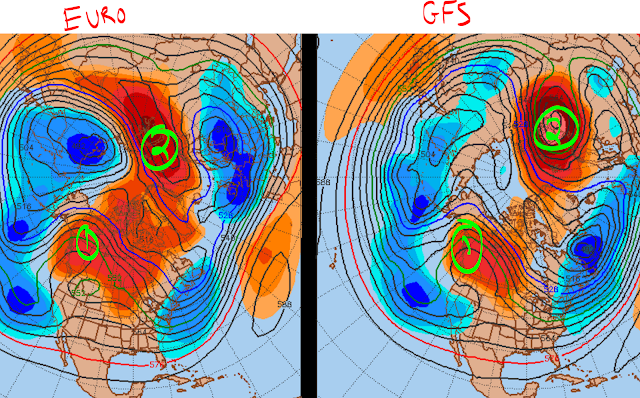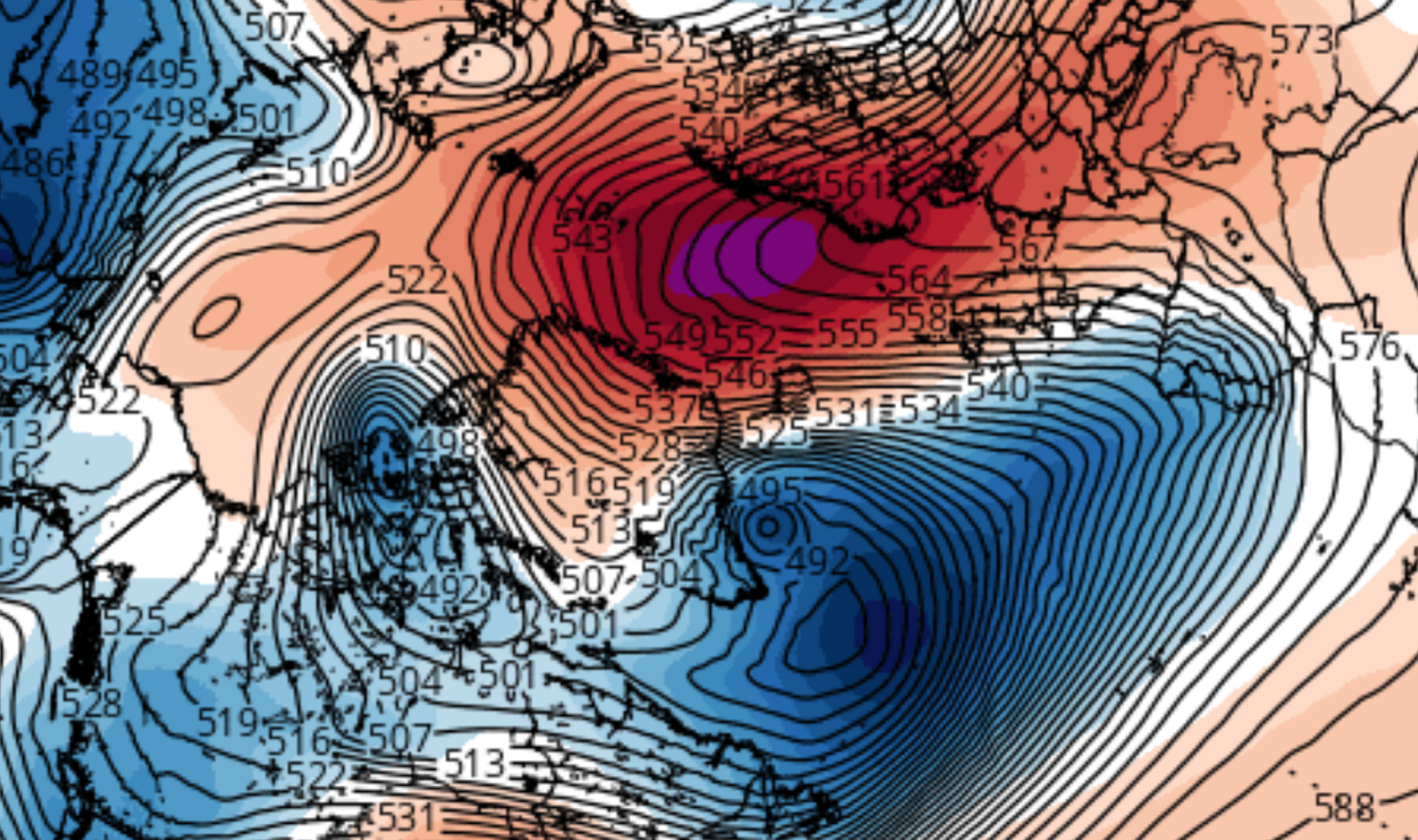The premise of this blog is to give you my thought's to when I believe the pattern will enter full winter throttle mode. First off, I hope everyone had a nice Christmas. I got to spend it with my family and enjoyed every minute of it. Something about Italians and Christmas.
Current Status of El Nino
Poor El Nino. This cyclical phenomena has been getting blamed by the general public for bringing 70+ degree temperatures to the Northeast in December. Its been in a strong amplitude phase and has not really shown signs of substantial weakening to moderate levels. I do think El Nino has peaked, but lets see why I think that's the case.
850hPa zonal wind anomalies over the Equatorial Pacific show strong easterlies overtaking 120W and points east (Nino Regions 3 & 1+2). Meanwhile, another round WWB's (Westerly Wind Bursts) are forecasted over the International Dateline (Nino Region 3.4). If you look at the first graphic I posted, the strongest SST anomalies are located between 150W and 100W or so. With easterlies expected over most of this area, we should see gradual cooling of SST's continue taking place. The upcoming WWB is a result of an active MJO. I will talk about this later on.
Mean SST anomaly changes over the last 7 days over Nino Region 1+2 shows cooling already taking place. We've seen persistent easterlies over this area for much of December. The stronger easterlies expected over the next 2 weeks should have greater impact.
Subsurface Equatorial SST Anomalies has shown negative departures gradually shift east through December. Subsurface negative departures are approaching 150W but they remain at depth. Once upwelling takes places, this is a sign ENSO is transforming from El Nino to La Nina. Overall, I expect this gradual / slow weakening of El Nino to last all winter long. The good news is - given the look of zonal winds and movement of subsurface temps - I think this event has peaked.
MJO to Jump Start the Sub-Tropical Jet Stream
The MJO - a tool that tracks tropical waves / areas of convection along the Equator - is heading into phase 7. This region is located in the western Pacific. As this wave approaches the Dateline, westerlies will increase and -OLR (Outgoing Longwave Radiation) will develop. The graphic on the right is a 500mb height anomaly composite of MJO phase 7 under an ENSO positive regime. Under this type of MJO forcing, blocking conditions - or positive heights - take over the Arctic. A trough develops over the SW U.S. and negative heights are seen across the entire U.S.
The MJO pulse is nicely shown at 200hPa / Outgoing IR Radiation. The brown contours in the western Pacific indicates positive Velocity Potential, where there is subsidence and weak convection. Closer to the Dateline, we see enhanced convection and negative VP, or CHI (divergence).
A Check on the Stratosphere
In the short term, there are positive signals in the Stratosphere in an effort to weaken / displace / split the Polar Vortex. Another round of increased 10hPa vertical forcing (EPV) from the Troposphere into the Stratosphere is expected to occur this weekend. Heat flux at 30hPa is on the rise in the same time frame. The idea is to keep putting force on the PV until we get the end result we're looking for. Keep in mind in order to see sustained negative AO conditions, we need to split or displace the Stratospheric PV out of the North Pole.
500mb height anomalies over the next 7-10 days show impressive height increases in western NA and Scandinavia (eventually into western Russia). This type of Tropospheric response has substantial implications in the lower Stratosphere.
In the lower Stratosphere, or 100hPa, the PV is expected to split sometime this weekend or early next week. But notice at 10hPa, or the upper Stratosphere, the PV is still intact and looks fairly strong. This is typically known as a bottom-up warming process. A true SSW means all levels of the Stratosphere show the PV splitting or being displaced. The reason we're seeing the PV split in the lower Stratosphere is due to the anomalous ridging in the upper Troposphere. The Scandinavian and the western Canadian ridges exert intense force, or push, on the lower Strat PV that it elongates and eventually splits.
The EURO nicely demonstrates the magnitude of the wave 1 and wave 2 forcing the Strat PV is about to witness 7-10 days from now. Unfortunately, it will not have much effect to the upper Stratosphere. It does appear the vorticity scatters and the core of the PV elongates, but that is not enough to bring the Tropospheric response we're looking for.
A starting point to seeing warmth propagate to the upper Stratosphere is the reduction of zonal winds at 10hPa. The GFS model drastically reduces 10hPa zonal winds from January 3rd onward. A weaker PV has higher probability of being influenced by Rosby Wave movement from the lower Strat to the upper Strat. Additionally, another round of vertical wave propagation is expected to occur around January 10th or so. There is a good shot this wave is stronger than the one's we've seen up to this point. If this is true, it could be exactly what we need to get the upper Strat to cooperate.
Pattern Change Schedule
Right after New Years, the EPS are showing the aforementioned ridges that will bring short-term implications to the lower Stratosphere. For our sensible weather, the +PNA spike and Tropospheric PV split will bring normal to below normal temperatures to our area the first 5-7 days of January. The trough axis over the east coast is too far east to promote coastal storm development. We're likely to be on the dry side the first few days of the month.
By the end of the first week of January, the Scandinavian ridge moved into western Russia and is beginning to amplify into Greenland. The +PNA evolves into a -EPO and this turns our AO from positive to negative. Keep in mind a lot of these developments are due to the Tropical / MJO forcing I talked about earlier. Pieces of upper level energy are forecasted to break off the eastern Siberian PV and work there way down into the Aleutians into the SW U.S. The lower heights in the southern tier of the country is indicative of an active Sub-Tropical Jet Stream. It will not take much for one of these pieces of energy to ride the STJ up the east coast. However, I'm not sure there will be enough cold air available over the east to promote wintry precipitation. At this point, the pattern is still volatile / evolving and a cross-polar flow is not yet established.
By the 2nd week of January, there is a better defined / organized Aleutian trough and substantial heights rises over the Arctic. I am not ready to jump on the -NAO train yet, but the anomalous ridges over Russia and Western NA bridge together to produce a blocking pattern that just may take our NAO negative. Much of the U.S. is under below normal heights at this time with a raging STJ. This is when the pattern begins to get exciting and possibly deliver our first significant east coast winter storm of the season.
Upper Level Pattern Change Schedule
Week 4 December: Old pattern regime continues. Expect to continue seeing above normal temperatures.
Week 1 January: Pattern transition begins due to the pulsing MJO into phase 7 / progression of the Scandinavian Ridge. Periods of below normal temperature days mixed with a day or two of slightly above normal.
Week 2 January: The strongest wave of energy transfer from the Troposphere to the Stratosphere should occur and an upper Strat PV displacement is probable. A blocking pattern over the Arctic in conjunction with an active STJ could result in our first significant east coast winter storm event of the season.
Week 3 January: Another period of relaxation is possible depending on whether or not the blocking pattern has staying power. That said, the development of the Aleutian trough in week 2 should keep higher heights confined to western NA. So we could see a pattern that looks closer to week 1 of January. At this point, the Stratospheric PV should be displaced but Tropospheric changes will not arise until later on.
Week 4 January: Full scale pattern change should come to fruition this week. If memory serves me correctly, last winter we saw our pattern change around this time frame as well. By this point, I think we'll see a sustained -AO thank to PV displacement along with a +PNA. Depending on exactly where the Strat PV tracks to will dictate the evolution of the NAO. We're already seeing the QBO trend toward neutral levels. If this trend continues and the blocking pattern the 2nd week of January comes to fruition, it's possible the NAO goes negative much sooner than expected. For now, I think it will go negative around week 4 of January or week 1 of February.













